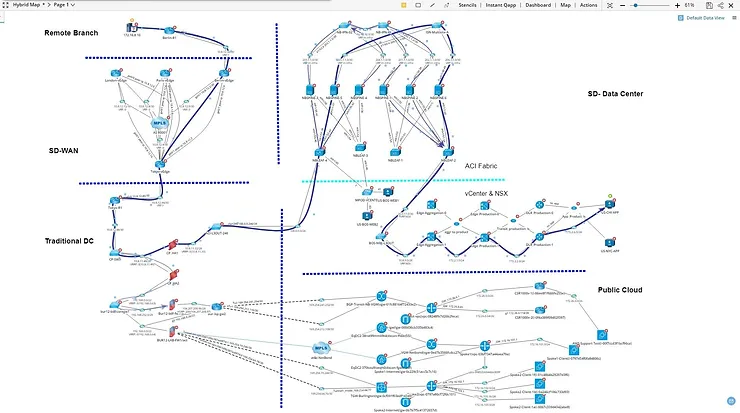Elevating Performance: The Art of Proactive IT Monitoring

Proactive IT monitoring is the cornerstone of a resilient and high-performing infrastructure. Most organization have up to 10 – 15 specialized monitoring tools. Each one with their specific niche, but with each monitoring tools, there is usually segmentation of data between teams, alert fatigue, scaling, and data overload with no real analysis.
The truth is monitoring is just as much art as it is technology. Let’s start with the core issues:
-
Alert Fatigue:
-
Problem: Too many alerts, many of which may be false positives, can lead to alert fatigue among IT professionals. Sorting through a high volume of alerts can be time-consuming and may result in critical issues being overlooked.
-
Solution: Implement intelligent alerting mechanisms that prioritize alerts based on severity and relevance. Use AI/Ops solutions to reduce false positives and provide actionable insights.
-
-
Complexity and Scalability:
-
Problem: IT environments are becoming increasingly complex with diverse technologies, distributed systems, and hybrid cloud infrastructures. Monitoring all components and ensuring scalability can be challenging.
-
Solution: Integrate your existing monitoring solutions into a comprehensive Visibility platform, and implement automation to handle repetitive tasks and ensure that the monitoring system can integrate with various technologies.
-
-
Data Overload and Analysis:
-
Problem: Collecting vast amounts of monitoring data is common, but the challenge lies in effectively analyzing and interpreting the data to derive meaningful insights. Without proper analysis, valuable information may be overlooked.
-
Solution: Implement advanced analytics and visualization tools to process and present data in a meaningful way. Use AI/Ops solutions that will help with anomaly detection to identify trends and potential issues before they impact system performance.
-
So where do you start? You start slowly and eat the elephant one bite at a time.
As your organization’s maturity grows, you will implement more advanced techniques to and integrate AI into your daily operations. Please do NOT jump right into AI/Ops, without doing some of the up-front work required. Otherwise, I promise you will have invested in another tool that doesn’t work the way you expected or intended.
1. Building Core Standards: What to Monitor
I know this step seems like a no brainer, but most organizations skip this step and implement a monitoring solution that will help them identify problems. Organizations need to define their core monitoring standards. This includes identifying critical metrics and key performance indicators (KPIs) specific to their infrastructure. Establishing these standards allows for a more comprehensive understanding of the system's health, priority and importance.
Implementation Steps
-
Collaborate with stakeholders: Work closely with different teams and departments to understand their specific needs and expectations from the monitoring system.
-
Develop monitoring templates: Create standardized templates for monitoring different types of components. This ensures consistency across the infrastructure.
What you monitor depends on what’s important to you. Here a few examples to get your brain going:
-
Latency Monitoring:
-
Throughput Monitoring:
-
Error Rate Monitoring:
-
Transaction Monitoring:
-
Resource Utilization Monitoring:
-
Queue Length Monitoring:
-
DNS Resolution Monitoring:
-
Certificate Expiry Monitoring:
-
Database Query Performance Monitoring:
-
API Monitoring:
-
User Authentication Monitoring:
-
Custom Application Metrics:
2. Reducing Noise: Alert Filtering and Consolidation
Once you are monitoring, the influx of alerts can be overwhelming. To address this, advanced monitoring systems employ alert filtering and consolidation techniques. By intelligently grouping related alerts and filtering out non-critical ones, IT teams can focus on actionable insights, reducing response times.
Implementation Steps:
-
Prioritize alerts: Classify alerts based on their criticality to the business. Focus on high-priority alerts that directly impact operations.
-
Implement alert correlation: Use tools that can correlate related alerts, reducing redundancy and providing a clearer picture of the underlying issues.
-
Fine-tune thresholds: Adjust alert thresholds to reduce false positives, ensuring that alerts are triggered only when a genuine problem arises.
3. Defining Critical paths
As IT environments become more complex, understanding the flow of data becomes crucial. Most will call this step “Data flow monitoring” which involves tracking the movement of data across networks, servers, and applications. This insight helps in identifying bottlenecks, potential security threats, and optimizing overall performance. The real goal though is to be able to understand a business function and be able to monitor the entire critical path of that business function. This allows all teams, management, application, and infrastructure to identify where the problem is located.
Implementation Steps:
-
Identify critical data paths: Determine the key data flows within your network and applications.
-
Use network and application monitoring tools: Implement solutions that capture and analyze network traffic, application logs, compute, storage and VM.
-
Integrate your topology map built in our last blog (Effective Asset Mapping) with the data from these monitoring tools to show an end to end critical path of a business function.
4. AI Operational Monitoring and Proactive Alerting
The pinnacle of IT monitoring maturity lies in the integration of Artificial Intelligence (AI). AI operational monitoring involves leveraging machine learning algorithms to predict issues before they occur. Proactive alerting based on historical data and patterns enables organizations to address potential problems in real-time, minimizing downtime and maximizing performance.
Implementation Steps:
-
Choose an AI/Ops solution that leverages machine learning to analyze historical data and predict potential issues.
-
Train AI models: Feed historical data into AI models to help them learn normal patterns and behaviors.
-
Implement automated responses: Set up automated actions based on AI predictions, allowing the system to address issues without human intervention.
I know that each of these steps could be it’s own blog post, but hopefully it starts giving you an idea around how to better implement monitoring into your environment. I also know that most of you reading this will have monitoring already installed and somewhere down this path. If you are struggling or have more questions, please do reach out.
Vsol specializes in the consultancy, management and advisory of data center, infrastructure and IT operations services.

